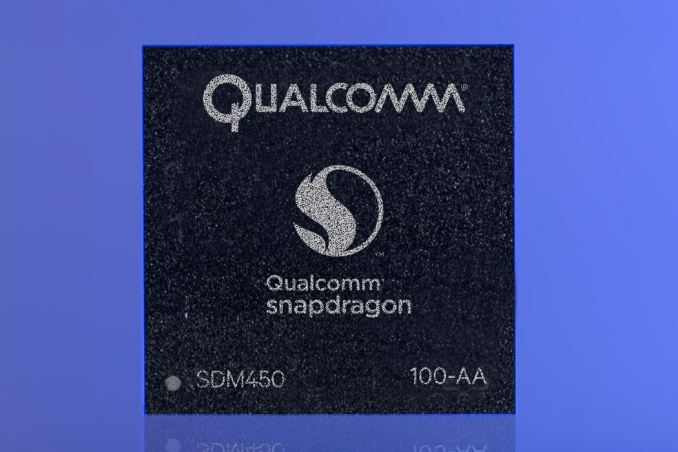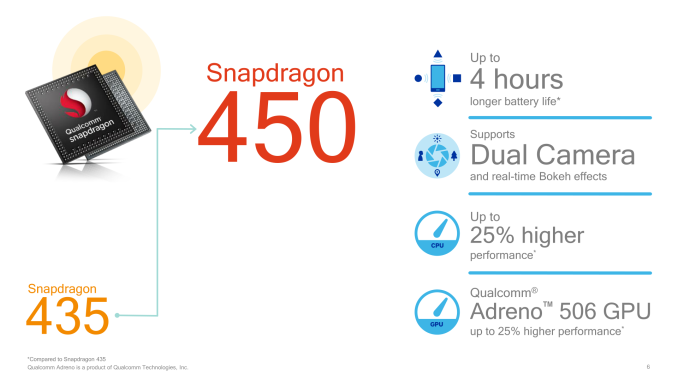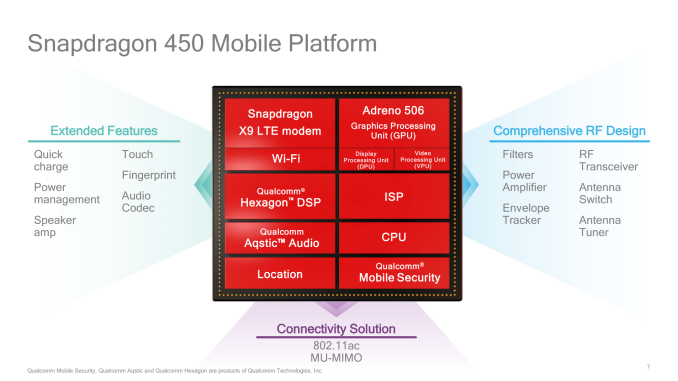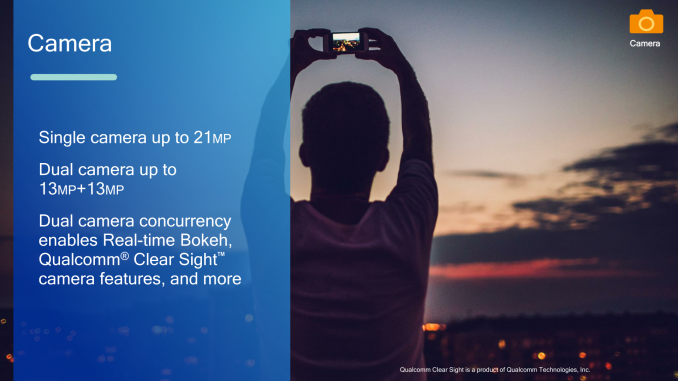Qualcomm Announces Snapdragon 450 Midrange SoC
by Ryan Smith on June 28, 2017 2:00 AM EST
Kicking off today is second Mobile World Congress of the year, MWC Shanghai. As the de facto home of smartphone manufacturing, and home for an increasing number of major mobile device vendors, the tradeshow has taken on increased importance in recent years. This year is no exception, with several different announcements of note coming out of the show.
Starting things off for everyone is Qualcomm, who is at the show to announce their latest mainstream Snapdragon 400 series SoC: the Snapdragon 450. The successor to Qualcomm’s 2016 Snapdragon 435, the Snapdragon 450’s biggest claim to fame is also its smallest: it will be the first Snapdragon 400 series SoC to be fabbed at 14nm, finally moving Qualcomm’s mainstream SoC lineup off of 28nm LP and on to a more recent and more power efficient manufacturing node.
| Qualcomm Midrange Snadpragon Family | ||||
| SoC | Snapdragon 450 | Snapdragon 435 | Snapdragon 625 | |
| CPU | 4x A53 @ 1.8GHz 4x A53 @ 1.8GHz |
4x A53 @ 1.4GHz 4x A53 @ 1.4GHz |
4x A53 @ 2.0GHz 4x A53 @ 2.0GHz |
|
| Memory | 1x 32-bit LPDDR3 | 1x 32-bit @ 800MHz LPDDR3 6.4GB/s b/w |
1x 32-bit @ 933MHz LPDDR3 7.45GB/s b/w |
|
| GPU | Adreno 506 | Adreno 505 | Adreno 506 | |
| Encode/ Decode |
1080p H.264 & HEVC (Decode) |
1080p H.264 & HEVC (Decode) |
2160p H.264 & HEVC (Decode) |
|
| Camera/ISP | Dual ISP 13MP + 13 MP (Dual) 21MP (Single) |
Dual ISP 8MP + 8MP (Dual) 21MP (Single) |
Dual ISP 24MP |
|
| Integrated Modem |
"X9 LTE" Cat. 7 300Mbps DL 150Mbps UL 2x20MHz C.A. (DL & UL) |
"X9 LTE" Cat. 7 300Mbps DL 100Mbps UL 2x20MHz C.A. (DL & UL) |
"X9 LTE" Cat. 7 300Mbps DL 150Mbps UL 2x20MHz C.A. (DL & UL) |
|
| USB | 3.0 w/QuickCharge 3.0 |
2.0 w/QuickCharge 3.0 |
3.0 w/QuickCharge 3.0 |
|
| Mfc. Process | 14nm | 28nm LP | 14nm | |
At a high level, the Snapdragon 450 is a very straightforward successor to the 435. Qualcomm has taken most of the 435’s design principles and brought them forward for the smaller Snapdragon 450. For example, we’re still looking at an octa-core ARM Cortex-A53 implementation, however thanks to the 14nm process Qualcomm has been able to bump up the maximum clockspeed from 1.4GHz to 1.8GHz. Similarly, Qualcomm has updated the GPU from an Adreno 505 on the Snapdragon 435 to an Adreno 506 on the Snapdragon 450, with the more powerful GPU said to offer 25% better performance.
Meanwhile more significant upgrades have been made to the ISPs and USB controller. Similar to the Snapdragon 435, the 450 supports a single camera at up to 21MP. However if it’s used in a dual camera configuration – as is increasingly popular these days for artificial Bokeh and telephoto modes – then it can handle a pair of 13MP sensors, up from 8MP on the Snapdragon 435, and a notable improvement as 13MP seems to increasingly be the baseline for midrange phones. Qualcomm’s video processor blocks have also been improved, in part to keep up with the improved sensor, and as a result the 450 can now capture video at up to 1080p60, doubling the maximum framerate over the Snapdragon 435’s 1080p30 limit. Meanwhile the USB controller has been upgraded from USB 2.0 to USB 3.0, allowing for much faster transfers from Snapdragon 450 devices. And, like its predecessor, the 450 also supports QualComm’s QuickCharge 3.0 tech over said USB port.
Cellular connectivity is once again provided by Qualcomm’s Integrated X9 modem, which supports LTE Category 7 down and Category 13 up, for a maximum of 300Mbps down and 150Mbps up respectively. Interestingly, on the Snapdragon 435, Qualcomm limited that SoC for just 100Mbps up despite the fact that Category 13 allows for 150Mbps; so this is the first X9-equipped Snapdragon 400 SoC to actually be able to hit 150Mbps up, going by Qualcomm’s specifications. The 450 also retains the 435’s Hexagon DSP, however like so many other parts of the SoC, the 450’s DSP has been further enhanced to reduce power consumption.
Last but not least, Qualcomm is promising some solid battery life improvements with the Snapdragon 450 over its 435 predecessor. While the company has invested some of their 14nm gains in improving clockspeeds throughout the chip, they’ve also retained a lot of those gains for reducing overall power consumption, a philosophy similar to what they did with the Snapdragon 835 this year as well. To that end the company is promoting that Snapdragon 450 phones will be able to deliver 4 hours more battery life relative to 435 phones.
Overall it’s interesting to note just how much the Snapdragon 450 sounds a lot like Qualcomm’s Snapdragon 625, their 14nm SoC from 2016. Both chips use a octa-A53 CPU configuration, X9 LTE modem, and Adreno 506 GPU. In fact the Snapdragon 450 is even pin compatible with the Snapdragon 625, which means that handset manufacturers can immediately begin working with the new SoC in existing designs. However given this close similarity, I’m also left to wonder whether the Snapdragon 450 is a new die, or a cut-down 625. In any case, the two chips still have some differences between them: particularly that the Snapdragon 625 clocks higher and features a more powerful ISP and video decode block.
Wrapping things up, as is often the case with Qualcomm’s SoC reveals, today’s announcement comes ahead of vendor sampling and wide release. The company will begin commercial sampling in Q3 of this year, and the chip should show up in retail devices by the end of the year.
Source: Qualcomm




















17 Comments
View All Comments
Wardrive86 - Wednesday, June 28, 2017 - link
Good to see this combo going down in price. The adreno 506 is a very powerful GPU, and I'm glad to see the entry level being brought up so high. Seeing as how A53 offers performance on par with much higher clocked Kraits, and slightly lower clocked A15s then this is just awesome. Coincidentally clock for clock they come pretty close to early Core 2 duo CPUs. Good for everyone!jjj - Wednesday, June 28, 2017 - link
A rebrand seems more likely here., the 630 replaces the 625 so they might as well do this.Spunjji - Wednesday, June 28, 2017 - link
Pretty transparent rebrand / neutering of the 625. Creating a whole new chipset with such similar specifications would be an odd move, so this makes sense. I do wonder why they felt the need to gimp the video encode capabilities though. Yayyy product segmentation.StrangerGuy - Wednesday, June 28, 2017 - link
It's already disturbing about how "new" phones with A53-only cores are rapidly approaching prices of "old" SD820 former flagships.jimjamjamie - Wednesday, June 28, 2017 - link
"Midrange"ok then
Ryan Smith - Wednesday, June 28, 2017 - link
Officially, the company considers the 200 to be entry-level, with the 800 and 600 being distinctly flagship and high-end, respectively.http://images.anandtech.com/galleries/5709/snapdra...
That said, for the US market where you won't see the 200, the 400 is functionally an entry-level SoC.
hybrid2d4x4 - Wednesday, June 28, 2017 - link
Why is a "midrange"/lower-end chipset still packing 8 slow cores? I really hope that this disastrous "more cores is better" arms race will backpedal at some point, as the very high pixel-count sensors have rolled back from ~20MP back down to a more reasonable 12MP for such small sensors.Are 8 cores perceptibly better in usage than 4 cores? I really doubt it. This could have easily been a quad or maybe even a dual-core and outside of multi-thread CPU benchmarks, nobody would've noticed. As much as dislike Apple, they are the only ones in the mobile space that don't participate in the superficial spec arms race (core counts, screen res, camera megapixels) and in this case they are still wiping the floor on the SoC front with "only" 2 fast cores+2 slow cores. That is what a mid-range SoCs should be, IMO. More cores can be labelled high-end to appease the benchmarkers, but the low and mid-end segments would be much better served by trading core count for better IPC, or even the slight efficiency improvements of not having these vestigial extra cores.
StrangerGuy - Wednesday, June 28, 2017 - link
Because being an average Android handset vendor these days = lousy profit margins. Can't use the much better SD660 SoC for the lower end because that would cannibalize their already tiny volume flagship segment.Valis - Sunday, July 2, 2017 - link
SD660 is one of the best mid-range SoCs right now, it has good CPU, decent GPU and doesn't consume much either. =)Ajr2017 - Thursday, September 7, 2017 - link
At least in my Snapdragon 430 handset even Facebook put uniform load in at least 6 cores, only emulators and old games(before 2014) uses 4 cores or less